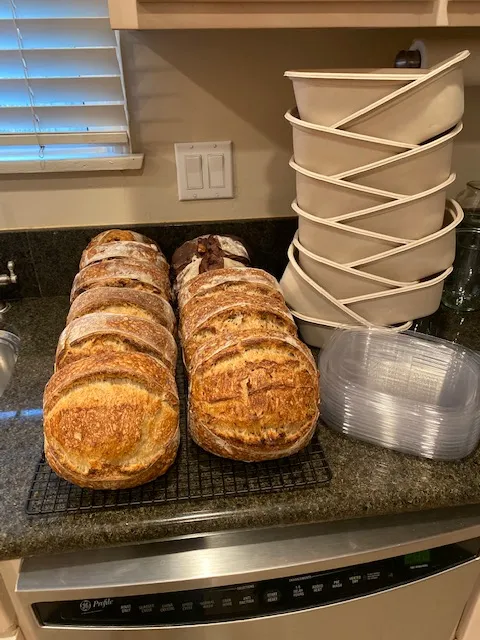
Got a bit ambitious yesterday and did a 12 loaf bake. 4 types of Sourdoughs, 3 loaves each. Just want to share my process that I feel pretty good about now and is quite streamlined. These are about 650g - 800g each.
1) Country Sourdough
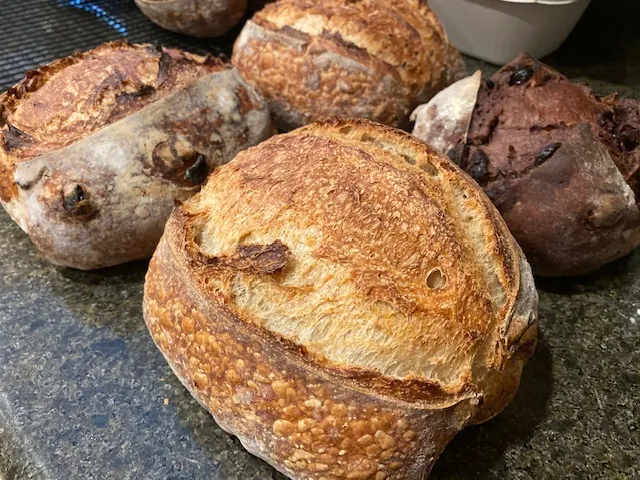
2) Cranberry Walnut
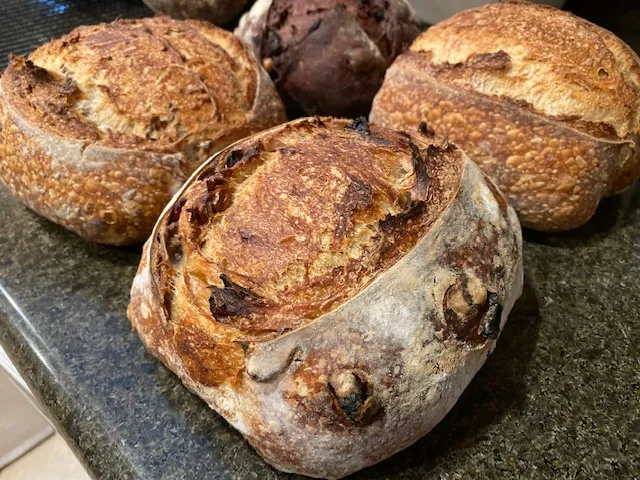
3) Chocolate Hazelnut with Raisins
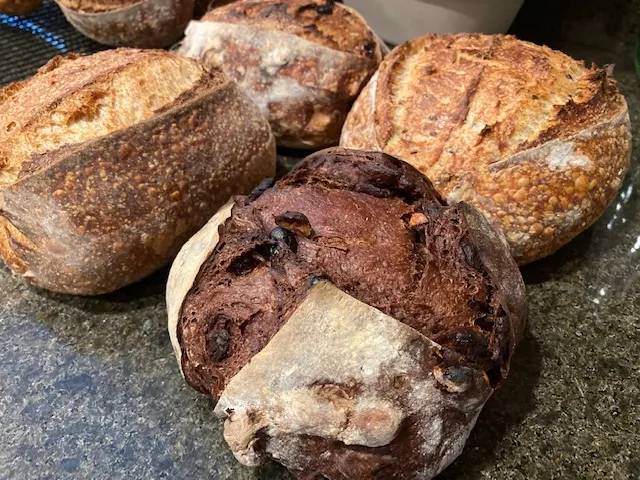
4) Seeded Sourdough (Flaxseed, sunflower seed, pumpkin seed)
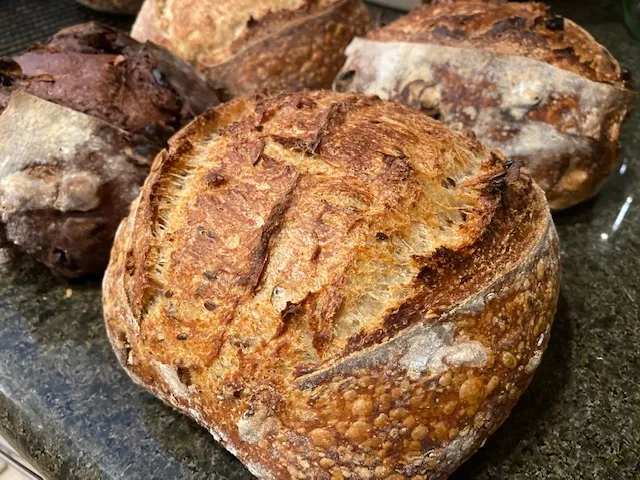
Getting pretty comfortable with making these now, and know the dough by feel rather than time. Streamlining the process and very repeatable.
In the morning, I setup 4 Weck jars for my levain and let them get just above doubling. I dont worry too much about how much starter I use with each jar. the more starter, the faster the levain matures. anything between 10-40g starter and i just add in enough flour/water to make the target 200g levain and depending on ratio of starter, it will mature faster or slower.
When levain is ready, I mix the levain with flour, water and even salt all at once in the KA mixer for a few minutes and then empty into large Pyrex glass bowl with lid. Repeat for all 4 doughs. I used to fermentolyse and add in salt 30 minutes later with some withheld water. but that means the dough would have to go into the mixer twice. To streamline, I just mixed in one go. Do not notice much difference. 30 - 50 min rest. 3 folds to 4 folds. Add-ins go in after 2nd fold (before passing window pane test, it integrates better and more evenly the sooner you add them in).
When dough is ready and passes window pane (doesnt need to be super strong otherwise too chewy). i leave it to final bulk for about 1-2 hours. About 20-30% volume increase. bubbly and just starting to get jiggly. divide each batch into 3 loaves by weight. Too much proofing here will result in reduced oven spring. Preshape on count using water spray and wet hands. 15-20 minute rest on counter (not covered). slight dusting of rice flour on top of dough balls and on counter for final shape. slight dusting again on shaped dough and put into paper bowls. I do not dust the bowls.
I'm using my paper pulp bowls with lids as brotforms / bannetons to hold for overnight cold retard. I can really fit a lot of these in the fridge. 12 was no problem.
Baked next day. I've done between 4 hours in the fridge to 16 hours in the fridge all with good success. After 4 hours the dough is not as firm as overnight, so more delicate when scoring and loading into oven.
I can bake 3 at a time in my oven. 2 batards in Lodge combo cooker/dutch ovens. and 1 smaller boule under a claypot. All of these on top of a baking stone. dough straight out of fridge. give it a little tuck to even out the shape a bit, score and go into preheated oven. 20 minutes covered @ 500F. 20-25 minutes uncovered with convection @ 450F. i put the cover of the dutch oven back under the base during the uncovered segment. this way, they stay hot for the next batch. I can do a batch in just over 45 minutes. no reheat necessary between sets. For the 4 batches from first set in to last set out was just over 3 hours for me.
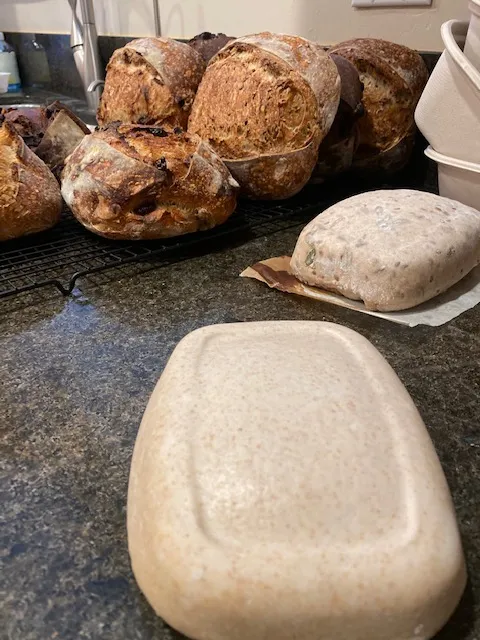
Dough looks funny and rectangular coming out of the bowl, but you wouldnt know from the finished loaves. I'm actually preferring these bowls to my bannetons now. just much easier and cleaner and i hardly use any rice flour dusting. They have a non-stick texture and doughs come out clean. I dont need to bag them because they have a lid. and after 10+ uses, they're still good as new. I wonder if i'll ever go back to the bannetons. Maybe for the larger loaves or if i want a fancier appearance with the rattan circle lines on it.
James
- ciabatta's Blog
- Log in or register to post comments
Wow, beautiful loaves and an impressive process. The paper pulp bowls sound like a great idea. Where did you get them?
Here
http://www.thefreshloaf.com/node/65391/paper-pulp-bowls
James it is awesome to see how well it has all come together for you. Each of those four varieties of loaves looks great. You are achieving it all, blisters, colour of crust, ears, bloom etc etc. Amazing way to get your intuition, skills and feel for the dough completely dialed in by baking so many loaves. You have a cool little micro bakery now. So happy for you.
Benny
It’s been an interesting journey the past months. A lot of bakes. I think I gone through over 300 lbs of flour. Lots of lessons learned for sure. Toyed with many ideas. Some worked out very well. Others not so much. Many thanks to you and everyone here at TFL for sure. And so much more to learn.
James
And I used to think DanAyo went a bit overboard.
Please tell me you sell bread at farmers markets.
--
300 pounds.... Six 50-lb sacks.... SIXTY 5-lb bags.
Every week, plus whatever else you bake, it’s easy to go through that amount of flour. I have 3 50 lb bags sitting in my basement. ?
I did share some of the flour and most of the bread.
Image
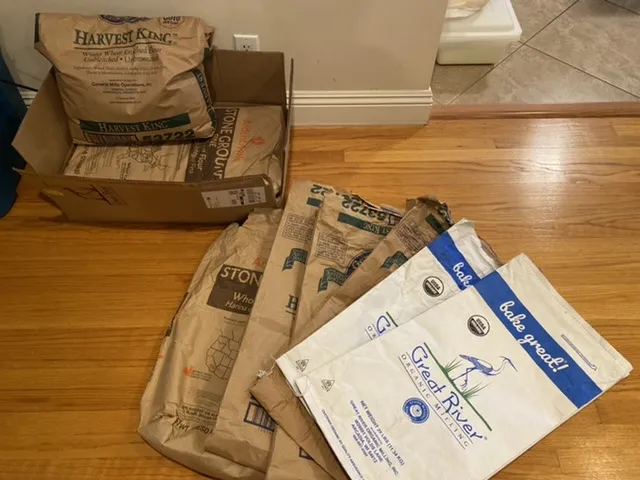
A bunch of 50 lb bags of bread and WW. Some 25 lb bags of rye. And lots of 5 lb bags of AP.
throwing in a couple of crumb shots for this bake
Wow the chocolate loaf looks decadent, still on my list of things to bake. Nice crumb on both loaves James.
For the chocolate loaf did you use cocoa powder, chocolate liquor or dark chocolate (I would worry about all the sugar in dark chocolate)?
cocoa powder in the dough and then 100g dark chocolate bar that I chop up and fold in. The recipe actually called for some brown sugar and honey but I accidentally left it out this time. I didn’t miss it.
now when you say you would worry about all the sugar. Do you mean how it affects the dough or just it is too much sugar to eat? (It would be too sweet for me to eat if more than half a slice)
james
but after thinking over my comment I do regularly make a bread that contains raisins and one with cranberries and walnuts so if I don’t worry about those sugars why would I worry about the sugar in chocolate adversely affecting the bread.
Technique! My loaves take 2 trips to the bowl as I use the second trip to develop the gluten. Tell me more about how you do your folds. I think I’d like to try this!
After coming out of the KA mixer, the dough rests for 30 mins in covered glass bowl. with wet hands and scraper, i loosen the dough and lift the middle and let front and back droop over and coil. then turn 90 degrees and repeat. If i feel like the dough is still loose and can take it i'll do another coil. but i dont want the dough to get tight or tear. rest 30-50 mins (depending on temp, adjust by feel). coil fold again. afterward put add-in on top and dimple them into the dough. more to distribute evenly more than anything. the next set of fold after rest will integrate them. i dont need super gluten development. just a decent weak window pane is fine. i dont want it to be too chewy. 1-2 hours for bulk. divide, preshape and final shape. into bowls and straight into fridge.
-James
Next question: How long in the KitchenAid? Or do you go by once the dough forms a cohesive round shape and cleans the edges of the bowl?
Mix time is probably 5 minutes. I’m really just trying to get even mix of all the ingredients. Not looking for gluten development. The dough is just too wet to clear edges. It’s sticky and loose coming out of the mix bowl. It doesn’t have much shape / gluten development even after the first fold. After the second fold it smooths out and begins to hold a little. That’s when the add-in are loaded. So more often than not it needs 4 folds.
What is your usual hydration if your dough is that wet? Mine is usually around 75%.
I plan to give your method a shot this week with a simple loaf with a few add-ins. I’m wondering if maybe I’m doing too much to develop the gluten as right now, I do a two hour true autolyse and at least 10 minutes in the mixer after the autolyse, then 3-4 coil folds after that!
Mine are around 70.5%. I found 75% to be a bit too wet for my flour. I went down to around 68 and eventually went back up to this. It’s 10% whole wheat for the country sourdough and the cranberry walnut. The seed loaf i did 20% WW. The bread flour is Harvest King 12% protein. I do spray water mist at various times to keep my hands, bowls, and scrapers from sticking. Wondering if I’m getting the hydration higher with that.
I don’t understand the seed soaker process. I didn’t have any luck with that the few times I tried. I do cold soak the flax seed with 100% hydration. But the sunflower and pumpkin come pre roasted. And I just mix them in dry with the soaked flaxseed.
By the seed soaker process. Do you mean putting wet seeds in the dough? That also made me wonder if you have tried this method with porridge breads? I’m going to give it a shot tomorrow and I think I’ll add some porridge in addition to some seeds. I’ll have to check my stash.
Yes, seed soaker or seed porridge. the process of soaking the seed add-ins into a porridge before mixing into dough. i dont know what hydration is right for what kind of seed and it messes with my overall hydration. i've had some very flat loaves in my attempts.
Walnuts, sunflower seeds, pumpkin seeds have all worked great just added in dry. And i think i prefer the nuts to stay more dry and maybe even crunchy in the end product. So, i'll stick with that.
i was doing 80g flaxseed (with 80g water) and then 50g sunflower and 50g pumpkin seed dry in a 1100kg flour batch (total weight around 1100 flour + 775 water + 260 seed mix + 20g salt = 2155g)
Most of the day. My porridge ends up rather stiff and I think I would have difficulty incorporating it by hand so I’m going to throw it into the initial mix and then add the seeds by hand like you do. Wish me luck! ??
Cia, this may have been before your time, so you may not have seen it.
http://www.thefreshloaf.com/node/61245/soaker-ingredient-hydration-percents-some-data
Check the comments for use instructions.
I hadn’t seen that! I have no idea how I missed that post. Super helpful!
It's late... my brain is hurting a little trying to read through and understand how this soaker hydration is determined. But some good stuff there for sure.
I also need to understand the benefit of soaked seeds vs dry seeds, as adding them in dry worked for me. Will read through in more details when my mind is fresh to see if i can make more of it.
Thanks,
James